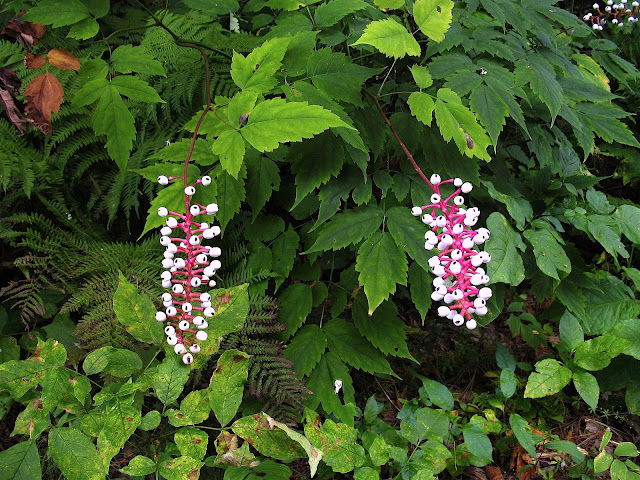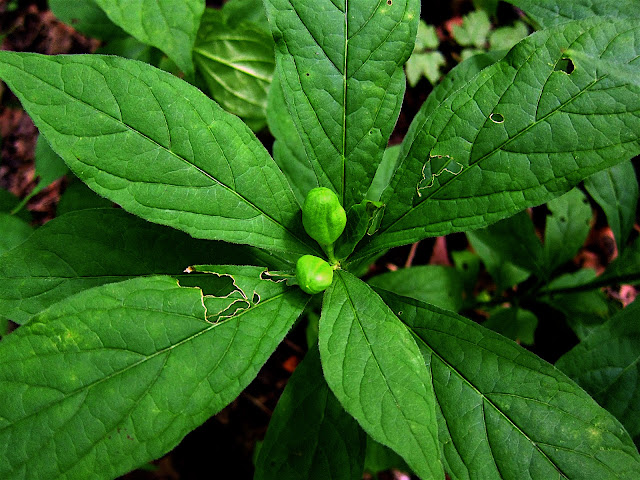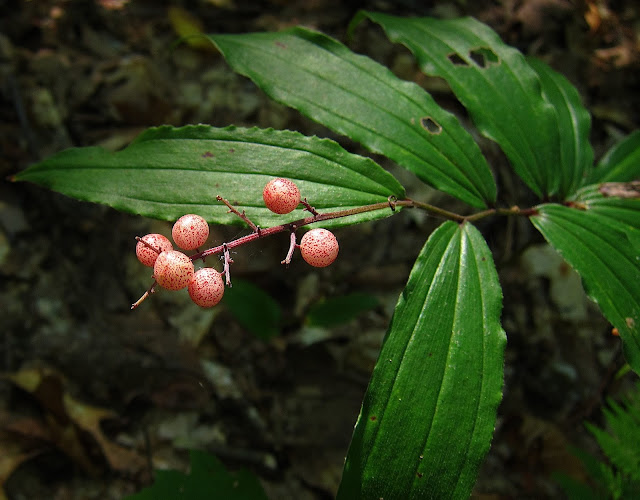I had a request from a friend to show him the seeds of Early Blue Cohosh (Caulophyllum giganteum), and that was an easy task for me. All I had to do was take him out to the nearby Skidmore Woods here in Saratoga Springs, where this species of Blue Cohosh thrives on that forest's limestone-underlaid soil. And the large seeds of this plant sure are easy to see, colored a lovely bright blue that stands out from the background greenery. They look like berries, but they are instead hard seeds covered with a thin blue skin, not juicy or fleshy as berries would be. You can sometimes find them looking just as pretty as this, even in the dead of winter, long after the leaves are gone.
For more than thirty years I've been wandering the woods and waterways of Saratoga County, New York, and regions nearby, looking closely, listening carefully, and recording what I experience. We are blessed in this region with an amazing amount of wilderness right at hand. With this blog I share my year-round adventures here, seeking out what wonders await in my own Madagascar close to home.
Friday, September 9, 2022
Summer Flowers Yield Fascinating Fruits and Seeds
Delighted by how pretty these seeds are, I decided to look around some of the other places I haunt, seeking out other examples of how our native wildflowers continue to bless us with their beauty, even after their spring and summer blooms have faded. Here are a few of the ones I found, so far.
The porcelain-white berries of White Baneberry (Actaea pachypoda) are far more showy now than their wispy white flowers had been last spring. And with this plant, the hot-pink pedicels rival for showiness the berries they hold. By the way, there's a reason this plant is called "Baneberry," since, despite how tempting they may appear, the berries are quite poisonous to humans.
The seedpods of Fringed Loosestrife (Lysimachia ciliata) won't broadcast their beauty across the swampy spots where they live, they are so small. You have to peer close to notice the shiny greenish-yellow orbs set within green stars.
When I noticed the shiny-red berries of this American Ginseng plant (Panax quinquefolia), I wondered if I should remove them. Most of the summer, this native plant has flourished among the surrounding Virginia Creeper and other low-growing woodland species, hidden from the eyes of poachers who might be tempted to uproot this valuable medicinal herb. But now those bright berries sure do attract attention. I wondered if covering the berries with leaf litter to hide them might provide an alternative to destroying them. The fruits are how this ever-rarer plant increases its population. So I did leave them.
Who would ever guess that these large tapering leaves were those of a violet? The seedpods, however, do offer a clue that this 18-inch-tall Green Violet plant (Hybanthus concolor) might be related to those more ground-hugging spring wildflowers.
I plucked a pod, three-parted like any violet seedpod, and opened it to reveal its spherical seeds. This part of the plant is about the only part that says "violet" to me. But it does belong to the Violet Family (Violaceae), even though its genus is not Viola.
These bright-orange fruits that circle the stem make this Orange-fruited Horse Gentian (Triosteum aurantiacum) easy to find this time of year. The meter-tall plants often hide among equally tall meadow flowers like goldenrods and native sunflowers, even when in flower with tiny red tubular flowers that by September produce these showy fruits.
The wispy greenish-white spring flowers of Indian Cucumber Root (Medeola virginiana) dangle beneath the top-tier of leaves, and usually go unseen. But eventually, the flowers migrate to crown the plant and hold high the clusters of shiny black fruits. This time of year, the still-green leaves often develop a splash of bright scarlet at the center.
The seedpods of American Lopseed (Phryma leptostachya) are neither large nor colorful, but they do have the fascinating behavior of bending straight down and clinging to the flower stalk. I am amused by the challenge of finding them, so skinny and greenish as to be nearly undetectable amid the general greenery of the forest floor.
I certainly have no trouble noticing patches of Partridgeberry (Mitchella repens), even when no scarlet fruits are peppering the carpets of shiny evergreen leaves that often spread widely across the forest floor. But this time of year, most patches do bear these shiny fruits that have a unique feature: each berry has two blossom ends! This is because each berry requires that two flowers, a pair of small white trumpets connected by a single ovary, be pollinated in order to produce the fruit.
I am quite puzzled by the appearance of Round-leaved Dogwood's berry clusters. Are all those tiny pink orbs aborted fruits that never developed into the greenish-white berries that otherwise develop on the cluster? Or are they some part of the berry that remains on the pedicels when the ripe fruit is removed? Whatever, the combination of white berries and tiny pink orbs atop deep-pink pedicels make this species of dogwood (Cornus rugosa) particularly attractive.
Eventually, the speckled fruits of Solomon's Plume (Maianthemum racemosum) will turn a translucent solid red when fully ripe. But it appears that some creatures have been quite happy to devour these berries already.
Although the two native woodland plants, Solomon's Plume (above) and Solomon's Seal (Polygonatum biflorum), can be confused when not in flower or fruit, by this time of year they are easy to distinguish. Instead of producing a terminal cluster of red fruits, Solomon's Seal bears blue-black berries, dangling in pairs from the leaf axils.
For years, I have hoped to find the ripe fruits of Spicebush (Lindera benzoin), because I have read that they taste like Allspice. They must taste like something good to whatever critters get there first, because I rarely find any ripe fruits on these shrubs that are very common in a local woods. But this year I DID find some. Almost ripe. I'll wait to pick one until it is fully ripe. (What are the odds there will be any left by then?)
This has been just a sampling of some of the colorful or otherwise interesting fruits and seedpods that can delight a woodswalker this time of year. I thought I had covered just about all of those that could be found right now, but then I noticed these pale-blue orbs held atop yellowish stars. The fading fruits of Starflower (Lysimachia borealis)! I'm so glad I noticed them before the seeds dropped to the ground.
Subscribe to:
Post Comments (Atom)















2 comments:
Reading your posts and enjoying the photos is almost like taking a walk with you. I learn something every time.
Lots of interesting seeds, and they're all so different.
Post a Comment